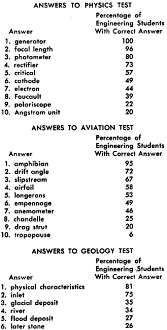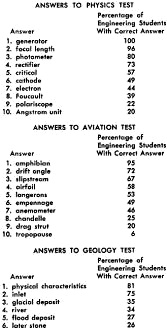| January 1953 Popular Mechanics |
 [Table of Contents] [Table of Contents]
Wax nostalgic about and learn from the history of early
mechanics and electronics. See articles from
Popular Mechanics,
published continuously since 1902. All copyrights hereby acknowledged.
|
 "Right
now America is crying for engineers - 50,000 of them." That is the tag line from
the "Wanted: 50,000 Engineers" article in the January 1953 issue of Popular
Mechanics magazine. The
Korean War was winding down (ended in July),
inflation
was low (0.7%, compared to 6-7% the last couple years, and 13% in Carter years)
and many technological breakthroughs generated a huge demand for engineers to design
products and systems to exploit and improve upon the knowledge. Here is an apt statement
from the article: "Just what is engineering? It has been called the art that makes
pure science useful." Magazines of the era were chock full of features like this
as well as advertisements attracting men - and sometimes women - to
tech schools, universities, industry,
military, and government through promises of great pay and prestige. Tests in
physics, aviation, and geology are included here to help the reader determine whether
he is engineer material. In truth, they are about as useful as the "Draw Me" type
ads for artist schools. "Right
now America is crying for engineers - 50,000 of them." That is the tag line from
the "Wanted: 50,000 Engineers" article in the January 1953 issue of Popular
Mechanics magazine. The
Korean War was winding down (ended in July),
inflation
was low (0.7%, compared to 6-7% the last couple years, and 13% in Carter years)
and many technological breakthroughs generated a huge demand for engineers to design
products and systems to exploit and improve upon the knowledge. Here is an apt statement
from the article: "Just what is engineering? It has been called the art that makes
pure science useful." Magazines of the era were chock full of features like this
as well as advertisements attracting men - and sometimes women - to
tech schools, universities, industry,
military, and government through promises of great pay and prestige. Tests in
physics, aviation, and geology are included here to help the reader determine whether
he is engineer material. In truth, they are about as useful as the "Draw Me" type
ads for artist schools.
Wanted: 50,000 Engineers
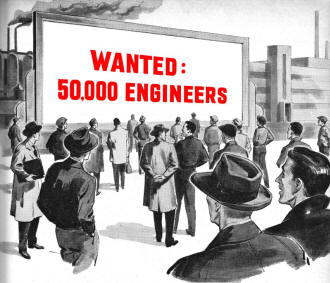
Wanted: 50,000 Engineers, January 1953 Popular Mechanics.
Here's a profession that's exciting, constructive and well-paid, yet authorities
see no end to the shortage of trained men. Readers of this magazine may have particular
abilities needed in this profession. Sample aptitude tests with this article help
indicate such abilities
By Carey H. Brown
Chairman, Engineering Manpower Commission
If you've ever dreamed of designing or building great bridges, huge monuments
to civilization in the far corners of the world, electronic wonders or rockets to
probe outer space, your chances of making those dreams come true were never better.
Provided, of course, that you have the basic qualities it takes to make an engineer.
And provided, too, you have the time for four to six years of essential college
work before you can create and build your first dream.
Right now America is crying for engineers - 50,000 of them. Worried men with
slide rules have figured that, with the rapid advance of scientific development
in every field, an additional 30,000 engineers will be needed every year in industry
alone. We're not even close to meeting that figure. By 1954, only 17,000 engineering
students will graduate. There are many reasons for this sad state of affairs. Unlike
our wartime allies, we drafted into military service thousands of engineering students,
many of whom never returned to the field. The low birth rate of the 1930s is now
aggravating the engineering-manpower shortage.
 But the important fact is that any young person
today who has an aptitude for engineering and is willing to work hard to develop
it is virtually assured of a fascinating job, a sound future, prestige and a salary
few fields can match. But the important fact is that any young person
today who has an aptitude for engineering and is willing to work hard to develop
it is virtually assured of a fascinating job, a sound future, prestige and a salary
few fields can match.
How good is it? The engineering students who graduated last June could pretty
well pick their jobs from a variety of offers with starting salaries of $300 to
$375 a month. In 10 years the good ones will be making two or three times that much.
Many of today's student engineers will have branched into scores of specialty fields
and spread to the four corners of the world-from the pipe lines of Saudi Arabia
to new mining developments under the rim of the Arctic Circle.
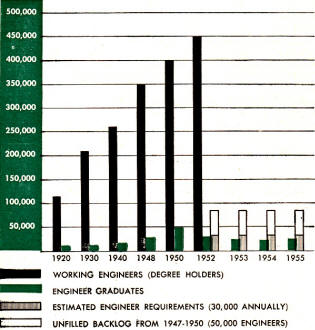 Just what is engineering? It has been called
the art that makes pure science useful. The engineer takes the formulas of the scientist
and puts them to work for mankind. He is far from an impromptu builder who goes
to work willy-nilly with sketchy plans and reliance on his handy ingenuity. Engineers
analyze, design and then supervise the building of nearly anything you can name
- railroads, radios, bridges, rockets, dams, power plants, radar and television
devices, engines, machines, industrial plants, pipe and transmission lines and thousands
of other things too numerous to mention. Their work carries them over deserts, mountains,
seas and snowbound wastes. Just what is engineering? It has been called
the art that makes pure science useful. The engineer takes the formulas of the scientist
and puts them to work for mankind. He is far from an impromptu builder who goes
to work willy-nilly with sketchy plans and reliance on his handy ingenuity. Engineers
analyze, design and then supervise the building of nearly anything you can name
- railroads, radios, bridges, rockets, dams, power plants, radar and television
devices, engines, machines, industrial plants, pipe and transmission lines and thousands
of other things too numerous to mention. Their work carries them over deserts, mountains,
seas and snowbound wastes.
Here's how it works. If you were a civil engineer hired to build a bridge across
the Amazon River, you would first learn exactly the functions your customer wanted
that bridge to perform. You'd plan in general how it could be done. You would visit
the site with a crew of surveyors. You would determine all the forces, in their
maximum degree, that would be brought to bear on the structure - like floods, earthquakes,
wind and the loads it should be designed to carry.
Several materials might do the job. Should it be steel or masonry? For each you'd
consider several possible arrangements. Should it be an arch bridge, suspension,
truss or cantilever? After reconnaissance and selection of the site, followed by
necessary investigations to acquire information on which to base the final design,
you and your associates would spend weeks or months designing each separate part
and making dozens of scale drawings. Then you'd draw up minute specifications and
descriptions for the entire project as it would be in final form on the Amazon site.
Nothing can be taken for granted. Every detail must be allowed for.
 Finally, you might have to supervise the construction
of your bridge, watch it grow through proper stages and satisfy yourself and your
client that everything you put into it would do the job it was supposed to do. Finally, you might have to supervise the construction
of your bridge, watch it grow through proper stages and satisfy yourself and your
client that everything you put into it would do the job it was supposed to do.
From all this, you might gather that unless you were a big, tweedy, six-foot
giant with a mathematical trap of a mind and a penchant for monstrous things and
wide-open spaces, you couldn't be an engineer. This is not so. Engineering encompasses
dozens of fields and myriad personalities. You can be fat, thin, tall, short, introvert
or extrovert. And no matter what your particular bent, if you have an engineering-type
mind, there's a niche you'll fit. You don't have to build a bridge or railroad;
it may be a power plant, an oil refinery, a chemical plant, a steel mill or a mining
project.
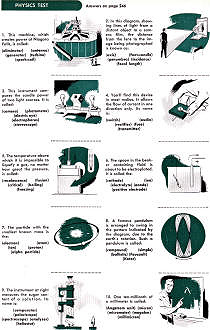 The profession breaks down into five big
fields. There are electrical engineers who work in electronic devices, communications
and electric-power generation, transmission and application. The mechanical engineer,
alone or in cooperation with other engineers, designs and builds anything that can
move or be moved - from monkey wrenches to steam engines. He produces airplanes,
rockets, jet power plants, turbines. It is the civil engineer who turns his talent
to the massive stationary monuments that decorate our modern landscapes - bridges,
dams, superhighways, railroads, underwater tunnels, water systems and other structures.
The chemical engineer takes what the chemist does in his laboratory and turns it
to industrial use. He creates the plastic objects you use today, synthetic fibers
and fabrics and a host of chemicals used in industry. Mining and metallurgical engineers
find ways to get minerals from the earth and, combine them to produce useful products
like stainless steel and many other alloys that make the things you use every day.
Others who have adopted a specialty may call themselves industrial engineers, manufacturing
engineers, aeronautical engineers, petroleum engineers or other designations indicating
their particular line of activity. The profession breaks down into five big
fields. There are electrical engineers who work in electronic devices, communications
and electric-power generation, transmission and application. The mechanical engineer,
alone or in cooperation with other engineers, designs and builds anything that can
move or be moved - from monkey wrenches to steam engines. He produces airplanes,
rockets, jet power plants, turbines. It is the civil engineer who turns his talent
to the massive stationary monuments that decorate our modern landscapes - bridges,
dams, superhighways, railroads, underwater tunnels, water systems and other structures.
The chemical engineer takes what the chemist does in his laboratory and turns it
to industrial use. He creates the plastic objects you use today, synthetic fibers
and fabrics and a host of chemicals used in industry. Mining and metallurgical engineers
find ways to get minerals from the earth and, combine them to produce useful products
like stainless steel and many other alloys that make the things you use every day.
Others who have adopted a specialty may call themselves industrial engineers, manufacturing
engineers, aeronautical engineers, petroleum engineers or other designations indicating
their particular line of activity.
Closely related to the engineer, and working hand in hand with him, are the designers,
draftsmen, detailers and surveyors. The surveyor is the chap you see on the site
of a big construction project, peering through his tripod-mounted transit. This
with his level, plane table, tape and photographic equipment are his principal tools.
He's an outdoor-type fellow, usually. He maps the site terrain, lays out the site
for the engineer, locates boundaries, sees that structures are at proper elevation
and grade, searches deeds and records. Though it helps, an engineering degree is
not a "must" for him.
 Engineering aides are highly respected men, essential
to the successful execution of engineering projects, whose principal training in
most cases has been on the job. Though sometimes applied to junior graduate engineers,
this term usually signifies a man whose technical training or experience falls short
of qualifying him as an engineer. Many of them have one to three years' training
in a technical school plus a vocational-high-school diploma. They might be called
the "top sergeants" of the profession and often command handsome salaries, but few
go on to executive positions because most companies now prefer graduate engineers
in those spots. Engineering aides are highly respected men, essential
to the successful execution of engineering projects, whose principal training in
most cases has been on the job. Though sometimes applied to junior graduate engineers,
this term usually signifies a man whose technical training or experience falls short
of qualifying him as an engineer. Many of them have one to three years' training
in a technical school plus a vocational-high-school diploma. They might be called
the "top sergeants" of the profession and often command handsome salaries, but few
go on to executive positions because most companies now prefer graduate engineers
in those spots.
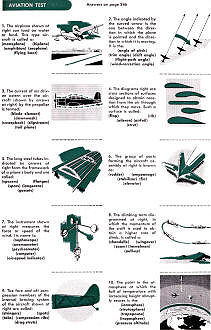 Another fellow who mayor may not have a
degree is the draftsman. This highly skilled craftsman makes finished drawings from
designs the engineer has roughed out. Some specialize in cartography, or map making.
In other specialties, such as machine design, the engineer and the draftsman work
side by side or their activities may merge. Unless the engineer's idea or design
is translated into proper drawings and specifications and thence into an adequate
structure or piece of equipment it's of little practical value. This illustrates
the importance of the engineering aide, the technician and the draftsman to the
engineering profession. Another fellow who mayor may not have a
degree is the draftsman. This highly skilled craftsman makes finished drawings from
designs the engineer has roughed out. Some specialize in cartography, or map making.
In other specialties, such as machine design, the engineer and the draftsman work
side by side or their activities may merge. Unless the engineer's idea or design
is translated into proper drawings and specifications and thence into an adequate
structure or piece of equipment it's of little practical value. This illustrates
the importance of the engineering aide, the technician and the draftsman to the
engineering profession.
All this is fine, but how can you tell if you have the qualifications to be an
engineer? There are a number of specific things that help make a good engineer.
Ask yourself these questions, posed by Dr. A. Pemberton Johnson, project director
of the Educational Testing Service. Try to answer them honestly.
1. Were your high-school-mathematics grades in the top third of your class?
2. Were your grades in physics, chemistry and other science courses in the top
third of the class?
3. Were your high-school English grades in the top half of your class?
4. Did you have sound habits of work and study?
5. Does your curiosity about things run high? (Do you wonder why radio signals
are weaker in daytime than at night? Why fluorescent bulbs are tube-shaped instead
of bulbous like standard lamps? Why aluminum is soft? Why concrete highways are
made of slabs instead of in a continuous strip ?)
6. Are you interested in improving things? If so, have you ever done something
about making an improvement?
7. Are you honest with yourself and other people?
 If you can answer "yes" to all these questions,
you have some of the faculties it takes. But there are many more. Though a four
or five-year undergraduate course in a good engineering school will give a man his
necessary degree, many engineers go on to graduate work and all must be prepared
for continual study to keep up with the rapidly advancing developments in the fields
of science. Many use night schools and correspondence courses. If you can answer "yes" to all these questions,
you have some of the faculties it takes. But there are many more. Though a four
or five-year undergraduate course in a good engineering school will give a man his
necessary degree, many engineers go on to graduate work and all must be prepared
for continual study to keep up with the rapidly advancing developments in the fields
of science. Many use night schools and correspondence courses.
The tests on these pages are samples of the type that help show your ability
to acquire and retain knowledge in fields that should interest a potential engineer.
Designed by Mr. Johnson O'Connor, director of the Human Engineering Laboratory,
Inc., and the Johnson O'Connor Research Foundation, Inc., they are parts of tests
now in actual use. They are helping to screen future engineers for large concerns.
If you do well on the samples shown here, it does not necessarily mean you should
plunge into engineering but indicates an interest in that direction, and you may
want to investigate further.
The best way to learn whether or not you have the basic engineering aptitudes
is to take aptitude tests. These are designed to indicate your ability to visualize
things in three dimensions; to determine the degree of your intellectual curiosity
and creative imagination, and to determine your personality type. The answers are
important for the prospective engineer to know. A quiet man with subjective personality
and high creative ability does best in design. A hail-fellow-well-met, with low
creative ability but objective personality will do better in construction.
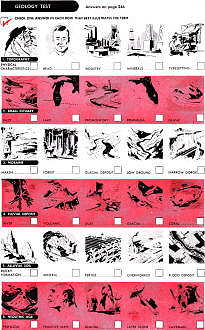 Robust health is essential for the engineer
whose work takes him into the field, where he must get around without handicaps
on dangerous construction jobs. Long hours of work call for reserves of stamina.
The engineer should be alert, persevering, reliable, willing to face staggering
problems without quailing. He must get along with people, since his work will ordinarily
require it. He must be forever curious about "things" and must have the ability
to visualize the objects which he thinks of. Robust health is essential for the engineer
whose work takes him into the field, where he must get around without handicaps
on dangerous construction jobs. Long hours of work call for reserves of stamina.
The engineer should be alert, persevering, reliable, willing to face staggering
problems without quailing. He must get along with people, since his work will ordinarily
require it. He must be forever curious about "things" and must have the ability
to visualize the objects which he thinks of.
In answer to a request from the government two years ago, the Engineers Joint
Council, which is made up of five major engineering societies, formed the Engineering
Manpower Commission located beside The Engineers' Club in New York City. The job
of this commission is to work toward the alleviation of the engineering-manpower
shortage. One way it is going about this is by interesting qualified young people
in the engineering profession. Advice, encouragement and help to young people from
all over is a part of the commission's function, and its New York office and its
local delegates throughout the country follow through on hundreds of inquiries that
come to their attention.
Our civilization today is permeated with engineering. A man with a recognized
engineering degree can find his place almost anywhere, in scores of seemingly unrelated
fields. Some engineers manage big businesses, like the presidents of many well-known
companies. City managers and public-works directors in many cities are engineers.
Government calls for more and more of them. Businessmen use engineers to survey
and analyze markets or even to formulate plans for advertising and sales campaigns.
Investment concerns turn to engineering advisors to evaluate the practical side
of new manufacturing proposals. Industry is dependent upon the continued supply
of qualified engineers.
Without proper preparation in high school - mainly in science and mathematics
- entrance into an engineering college or a technical school is difficult. So if
you think you want to be an engineer and set your sights on anyone of these goals,
start early and' you'll get there if you have what it takes.
 Physics Test Physics Test
1. This machine, which creates power at Niagara Falls, is called:
(eliminator) (antenna) (generator) (turbine) (spark-coil)
2. In this diagram, showing lines of light from a distant object to a camera
film, the distance from the lens to the image being photographed is known as:
(axis) (foot-candle) (penumbra) (incidence) (focal length)
3. This instrument compares the candle power of two light sources. It is called:
(camera) (photometer) (electric eye) (electrophorus) (stereoscope)
4. You'll find this device in most radios. It allows the flow of current in one
direction only. Its name is:
(switch) (audio) (rectifier) (fuse) (transmitter)
5. The temperature above which it is impossible to liquefy a gas, no matter how
great the pressure, is called:
(recalescence) (fusion) (critical) (boiling) (freezing)
6. The spoon in the beaker containing fluid is about to be electroplated. It
is called the:
(cathode) (ion) (electrolyte) (anode) (positive electrode)
7. The particle with the smallest known mass is the:
(electron) (atom) (ion) (proton) (alpha particle)
9. The instrument at right measures the sugar content of a solution. Its name
is:
(comparator) (polariscope) (spectroscope) (analyzer) (heliostat)
8. A famous pendulum is arranged to swing in the pattern indicated by the diagram,
due to the earth's rotation. Such a pendulum is called:
(compound) (simple) (ballistic) (Foucault) (Kator)
10. One ten-millionth of a millimeter is called:
(Angstrom unit) (micron) (micrometer) (megohm) (millimicron)
Aviation Test
The airplane shown at right can land on water or land. This type aircraft is
called a:
(monoplane) (biplane) (amphibian) (seaplane) (flying boat)
2. The angle indicated by the curved arrow is the one between the direction in
which the plane is pointed and the direction in which it is moving. It is the:
(angle of pitch) (trim angle) (drift angle) (flight-path angle) (wind-correction
angle)
3. The current of air driven astern over the aircraft (shown by arrows at right)
by the propeller is termed:
(blade element) (downwash) (sweepback) (slipstream) (tail plane)
4. The diagrams right are cross sections of surfaces designed to obtain reaction
from the air through which they move. Such a surface is called:
(flap) (rib) (aileron) (airfoil) (strut)
5. The long steel tubes indicated by arrows at right form the framework of a
plane's body and are called:
(spacers) (flanges) (spars) (longerons) (gussets)
6. The group of parts forming the aircraft assembly at right is known as:
(rudder) (empennage) (stabilizer) (fin) (elevator)
7. The instrument shown at right measures the force or speed of the wind. Its
name is:
(nephoscope) (anemometer) (psychrometer) (computer) (air-speed indicator)
8. The climbing term diagrammed at right, in which the momentum of the craft
is used to obtain a higher rate of climb, is called a:
(chandelle) (wingover) (zoom) (Immelman) (pull-up)
9. The fore and aft compression members of the internal bracing system of the
aircraft shown at right are called: (stringers) (spats) (tabs) (compression ribs)
(drag struts)
10. The point in the atmosphere at which the fall of temperature with increasing
height abruptly ceases is the:
(ionosphere) (stratosphere) (tropopause) (troposphere) (pressure altitude)
Geology Test
Check one answer in each row that best illustrates the term
1. Topography
___ Physical Characteristics ___ Head ___ Industry ___ Minerals ___ Typesetting
2. Small Estuary
___ Inlet ___ Lake ___ Promontory ___ Peninsula ___ Island
3. Moraine
___ Marsh ___ Forest ___ Glacial Deposit ___ Low Ground ___ Narrow Gorge
4. Fluvial Deposit
___ River ___ Volcanic ___ Dust ___ Glacial ___ Coral
5. Alluvial Soil
___ Rocky Formation ___ Mineral ___ Fertile ___ Overworked ___ Flood Deposit
6. Neolithic Age
___ Preflood ___ Primitive Man ___ Glacial ___ Later Stone ___ Caveman
Quizzes from vintage electronics magazines such as Popular
Electronics, Electronics-World, QST, and Radio News
were published over the years - some really simple and others not so simple. Robert P. Balin
created most of the quizzes for Popular Electronics. This is a listing
of all I have posted thus far.
- RF Cafe Quiz #71:
Tech Headlines for Week of 3/13/2023
- RF Cafe Quiz #70:
Analog &
RF Filter Basics
- RF Cafe Quiz #69:
RF
Electronics Basics
- RF Cafe Quiz #68:
RF & Analog Company Mergers & Acquisitions in 2017
- RF Cafe Quiz #67:
RF & Microwave Company Name Change History
- RF Cafe Quiz #66:
Spectrum and Network Measurements
- RF Cafe Quiz #65:
Troubleshooting & Repairing Commercial Electrical Equipment
- RF Cafe Quiz #64:
Space-Time Adaptive Processing for Radar
- RF Cafe Quiz #63:
Envelope Tracking Power Amplifiers
- RF Cafe Quiz #62:
Stimson's Introduction to Airborne Radar
- RF Cafe Quiz #61:
Practical Microwave Circuits
- RF Cafe Quiz #60:
Ten Essential Skills for Electrical Engineers
- RF Cafe Quiz #59:
Microwave Circulator Design
- RF Cafe Quiz #58:
Microwave and Millimeter-Wave Electronic Packaging
- RF Cafe Quiz #57:
Frequency-Agile Antennas for Wireless Communications
- RF Cafe Quiz #56:
Tube Testers
and Electron Tube Equipment
- RF Cafe Quiz #55:
Conquer
Radio Frequency
- RF Cafe Quiz #54:
Microwave Mixer Technology and Applications
- RF Cafe Quiz #53:
Chipless RFID Reader Architecture
- RF Cafe Quiz #52:
RF and Microwave Power Amplifiers
- RF Cafe Quiz #51:
Antennas and Site Engineering for Mobile Radio Networks
- RF Cafe Quiz #50:
Microstrip Lines and Slotlines
- RF Cafe Quiz #49:
High-Frequency Integrated Circuits
- RF Cafe Quiz #48:
Introduction to Infrared and Electro-Optical Systems
- RF Cafe Quiz #47:
LCP for Microwave Packages and Modules
- RF Cafe Quiz #46:
RF, Microwave, and Millimeter-Wave Components
- RF Cafe Quiz #45:
Dielectric and Thermal Properties of Materials at Microwave Frequencies
- RF Cafe Quiz #44:
Monopulse Principles and Techniques
- RF Cafe Quiz #43:
Plasma Antennas
- RF Cafe Quiz #42: The Micro-Doppler
Effect in Radar
- RF Cafe Quiz #41: Introduction
to RF Design Using EM Simulators
- RF Cafe Quiz #40: Introduction
to Antenna Analysis Using EM Simulation
- RF Cafe Quiz #39: Emerging
Wireless Technologies and the Future Mobile Internet
- RF Cafe Quiz #38: Klystrons,
Traveling Wave Tubes, Magnetrons, Crossed-Field Amplifiers, and Gyrotrons
- RF Cafe Quiz #37: Component
Reliability for Electronic Systems
- RF Cafe Quiz #36: Advanced
RF MEMS
- RF Cafe Quiz #35: Frequency
Synthesizers: Concept to Product
- RF Cafe Quiz #34: Multi-Gigabit
Microwave and Millimeter-Wave Wireless Communications
- RF Cafe Quiz #33: Battlespace
Technologies: Network-Enabled Information Dominance
- RF Cafe Quiz #32: Modern Communications
Receiver Design and Technology
- RF Cafe Quiz #31: Quantum
Mechanics of Nanostructures
- RF Cafe Quiz #30: OFDMA System
Analysis and Design
- RF Cafe Quiz #29: Cognitive
Radar
- RF Cafe Quiz #28: Human-Centered
Information Fusion
- RF Cafe Quiz #27: Remarkable
Engineers
- RF Cafe Quiz #26: Substrate
Noise Coupling in Analog/RF Circuits
- RF Cafe Quiz #25: Component
Reliability for Electronic Systems
- RF Cafe Quiz #24: Ultra Low
Power Bioelectronics
- RF Cafe Quiz #23: Digital
Communications Basics
- RF Cafe Quiz #22: Remember
the Basics?
- RF Cafe Quiz #21: Wireless
Standards Knowledge
- RF Cafe Quiz #20: Famous First
Names
- RF Cafe Quiz #19: Basic Circuit
Theory
- RF Cafe Quiz #18: Archaic
Scientific Words & Definitions
- RF Cafe Quiz #17: Inventors &
Their Inventions
- RF Cafe Quiz #16: Antennas
- RF Cafe Quiz #15: Numerical
Constants
- RF Cafe Quiz #14: Oscillators
- RF Cafe Quiz #13: General
Knowledge
- RF Cafe Quiz #12: Electronics
Corporations Headquarters
- RF Cafe Quiz #11: Famous Inventors &
Scientists
- RF Cafe Quiz #10: A Sampling
of RF & Wireless Topics
- RF Cafe Quiz #9: A Smorgasbord
of RF Topics
- RF Cafe Quiz #8: Hallmark Decades
in Electronics
- RF Cafe Quiz #7: Radar Fundamentals
- RF Cafe Quiz #6: Wireless Communications
Fundamentals
- RF Cafe Quiz #5: Company Logo
Recognition
- RF Cafe Quiz #4: General RF
Topics
- RF Cafe Quiz #3: General RF/Microwave
Topics
- RF Cafe Quiz #2: General RF
Topics
- RF Cafe Quiz #1: General RF
Knowledge
- Vacuum Tube Quiz,
February 1961 Popular Electronics
- Kool-Keeping Kwiz, June
1970 Popular Electronics
- Find the Brightest
Bulb Quiz, April 1960 Popular Electronics
-
Where Do the Scientists Belong? - Feb 19, 1949 Saturday Evening Post
|
-
What's Your EQ? - April 1967 Radio-Electronics
-
What's Your EQ? -
March 1967 Radio-Electronics
-
What's Your EQ? - December 1964 Radio-Electronics
-
What's Your EQ? - January 1967 Radio-Electronics
-
Wanted: 50,000 Engineers - January 1953 Popular Mechanics
-
What's Your EQ? - August 1964 Radio-Electronics
- Voltage Quiz
- December 1961 Popular Electronics
-
What is It? - June 1941 Popular Science
- What Do You Know
About Resistors? - April 1974 Popular Electronics
-
What's Your EQ? - September 1963 Radio-Electronics
- Potentiometer Quiz - September
1962 Popular Electronics
-
Mathematical Bafflers - March 1965 Mechanix Illustrated
- Op Amp Quiz -
October 1968 Popular Electronics
- Electronic "A"
Quiz - April 1968 Popular Electronics
-
What's Your EQ? - May 1961 Radio-Electronics
-
Popular Science Question Bee - February 1939 Popular Science
-
What is It? - A Question Bee in Photographs - June 1941 Popular Science
-
What's Your EQ? - June 1961 Radio-Electronics
-
What's Your EQ? - June 1964 Radio-Electronics
-
What's Your EQ? - May 1964 Radio-Electronics
-
What's Your EQ? - August 1963 Radio-Electronics
-
What's Your EQ? - May 1963 Radio-Electronics
- Bridge
Function Quiz - September 1969 Radio-Electronics
-
What's Your EQ? - March 1963 Radio-Electronics
-
What's Your EQ? - February 1967 Radio-Electronics
-
Circuit Quiz - June 1966 Radio-Electronics
-
What's Your EQ? - June 1966 Radio-Electronics
- Electronics
Mathematics Quiz - June 1969 Popular Electronics
- Brightest
Light Quiz - April 1964 Popular Electronics
-
What's Your EQ? - April 1963 Radio-Electronics
- Electronics "B" Quiz
- July 1969 Popular Electronics
- Ohm's Law Quiz
- March 1969 Popular Electronics
-
Antenna Quiz - November 1962 Electronics World
- Color Code Quiz
- November 1967 Popular Electronics
- CapaciQuiz
- August 1961 Popular Electronics
- Transformer
Winding Quiz - December 1964 Popular Electronics
-
Audiophile Quiz - November 1957 Radio-electronics
- Capacitor
Function Quiz - March 1962 Popular Electronics
- Greek Alphabet
Quiz - December 1963 Popular Electronics
- Circuit
Designer's Name Quiz - July 19680 Popular Electronics
-
Sawtooth Sticklers Quiz - November 1960 Radio-Electronics
-
Elementary
Radio Quiz - December 1947 Radio-Craft
- Hi-Fi
Quiz - October 1955 Radio & Television News
- Electronics Physics
Quiz - March 1974 Popular Electronics
- A Baffling Quiz
- January 1968 Popular Electronics
- Electronics IQ
Quiz - May 1967 Popular Electronics
- Plug and Jack
Quiz - December 1967 Popular Electronics
- Electronic
Switching Quiz - October 1967 Popular Electronics
- Electronic
Angle Quiz - September 1967 Popular Electronics
- International
Electronics Quiz - July 1967 Popular Electronics
- FM Radio
Quiz - April 1950 Radio & Television News
- Bridge Circuit
Quiz -December 1966 Popular Electronics
- Diode Function
Quiz - August 1965 Popular Electronics
- Diagram Quiz,
August 1966 Popular Electronics
- Quist Quiz - November
1953 QST
- TV Trouble Quiz,
July 1966 Popular Electronics
- Electronics History Quiz,
December 1965 Popular Electronics
- Scope-Trace Quiz,
March 1965 Popular Electronics
-
Electronic
Circuit Analogy Quiz, April 1973
-
Test Your Knowledge of Semiconductors, August 1972 Popular Electronics
- Ganged Switching
Quiz, April 1972 Popular Electronics
- Lamp Brightness
Quiz, January 1969 Popular Electronics
- Lissajous
Pattern Quiz, September 1963 Popular Electronics
- Electronic
Quizoo, October 1962 Popular Electronics
- Electronic
Photo Album Quiz, March 1963 Popular Electronics
- Electronic
Alphabet Quiz, May 1963 Popular Electronics
- Quiz: Resistive?
Inductive? or Capacitive?, October 1960 Popular Electronics
- Vector-Circuit
Matching Quiz, June 1970 Popular Electronics
- Inductance
Quiz, September 1961 Popular Electronics
- RC Circuit Quiz,
June 1963 Popular Electronics
- Diode Quiz, July
1961 Popular Electronics
- Electronic
Curves Quiz, February 1963 Popular Electronics
- Electronic
Numbers Quiz, December 1962 Popular Electronics
- Energy Conversion
Quiz, April 1963 Popular Electronics
- Coil Function
Quiz, June 1962 Popular Electronics
-
Co-Inventors Quiz - January 1965 Electronics World
-
"-Tron" Teasers Quiz - October 1963 Electronics World
- Polarity Quiz
- March 1968 Popular Electronics
-
Television
I.Q. Quiz - October 1948 Radio & Television News
- Amplifier Quiz
Part I - February 1964 Popular Electronics
- Semiconductor
Quiz - February 1967 Popular Electronics
- Unknown
Frequency Quiz - September 1965 Popular Electronics
- Electronics
Metals Quiz - October 1964 Popular Electronics
- Electronics
Measurement Quiz - August 1967 Popular Electronics
- Meter-Reading
Quiz, June 1966 Popular Electronics
- Electronic
Geometry Quiz, January 1965 Popular Electronics
- Electronic
Factor Quiz, November 1966 Popular Electronics
- Electronics
Math Quiz, November 1965 Popular Electronics
- Series Circuit
Quiz, May 1966 Popular Electronics
- Electrochemistry
Quiz, March 1966 Popular Electronics
- Biz
Quiz: Test Your Sales Ability - April 1947 Radio News
- Electronic
Analogy Quiz, November 1961 Popular Electronics
- Electronic
Coupling Quiz, August 1973 Popular Electronics
- Electronics
Analogy Quiz, August 1960 Popular Electronics
- Audio Quiz, April
1955 Popular Electronics
- Electronic Unit
Quiz, May 1962 Popular Electronics
- Capacitor
Circuit Quiz, June 1968 Popular Electronics
|
Answer
1. generator
2. focal length
3. photometer
4. rectifier
5. critical
6. cathode
7. electron
8. Foucault
9. polariscope
10. Angstrom unit
|
Percentage of Engineering Students With Correct Answer
100
96
80
73
57
49
44
39
22
20
|
Answer
1. amphibian
2. drift angle
3. slipstream
4. airfoil
5. longerons
6. empennage
7. anemometer
8. chandelle
9. drag strut
10. tropopause
|
Percentage of Engineering Students With Correct Answer
95
72
67
58
53
49
46
25
20
6
|
Answer
1. physical characteristics
2. inlet
3. glacial deposit
4. river
5. flood deposit
6. later stone
|
Percentage of Engineering Students With Correct Answer
81
75
35
34
27
26
|
Posted December 1, 2023
|

 "Right
now America is crying for engineers - 50,000 of them." That is the tag line from
the "Wanted: 50,000 Engineers" article in the January 1953 issue of Popular
Mechanics magazine. The
"Right
now America is crying for engineers - 50,000 of them." That is the tag line from
the "Wanted: 50,000 Engineers" article in the January 1953 issue of Popular
Mechanics magazine. The 
 But the important fact is that any young person
today who has an aptitude for engineering and is willing to work hard to develop
it is virtually assured of a fascinating job, a sound future, prestige and a salary
few fields can match.
But the important fact is that any young person
today who has an aptitude for engineering and is willing to work hard to develop
it is virtually assured of a fascinating job, a sound future, prestige and a salary
few fields can match. 
 Finally, you might have to supervise the construction
of your bridge, watch it grow through proper stages and satisfy yourself and your
client that everything you put into it would do the job it was supposed to do.
Finally, you might have to supervise the construction
of your bridge, watch it grow through proper stages and satisfy yourself and your
client that everything you put into it would do the job it was supposed to do.

 Engineering aides are highly respected men, essential
to the successful execution of engineering projects, whose principal training in
most cases has been on the job. Though sometimes applied to junior graduate engineers,
this term usually signifies a man whose technical training or experience falls short
of qualifying him as an engineer. Many of them have one to three years' training
in a technical school plus a vocational-high-school diploma. They might be called
the "top sergeants" of the profession and often command handsome salaries, but few
go on to executive positions because most companies now prefer graduate engineers
in those spots.
Engineering aides are highly respected men, essential
to the successful execution of engineering projects, whose principal training in
most cases has been on the job. Though sometimes applied to junior graduate engineers,
this term usually signifies a man whose technical training or experience falls short
of qualifying him as an engineer. Many of them have one to three years' training
in a technical school plus a vocational-high-school diploma. They might be called
the "top sergeants" of the profession and often command handsome salaries, but few
go on to executive positions because most companies now prefer graduate engineers
in those spots. 
 If you can answer "yes" to all these questions,
you have some of the faculties it takes. But there are many more. Though a four
or five-year undergraduate course in a good engineering school will give a man his
necessary degree, many engineers go on to graduate work and all must be prepared
for continual study to keep up with the rapidly advancing developments in the fields
of science. Many use night schools and correspondence courses.
If you can answer "yes" to all these questions,
you have some of the faculties it takes. But there are many more. Though a four
or five-year undergraduate course in a good engineering school will give a man his
necessary degree, many engineers go on to graduate work and all must be prepared
for continual study to keep up with the rapidly advancing developments in the fields
of science. Many use night schools and correspondence courses. 
 Physics Test
Physics Test 